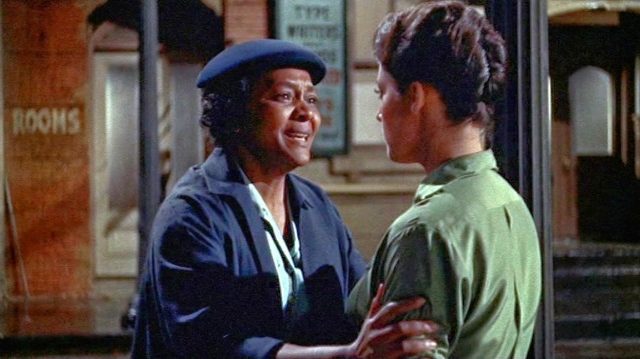My immediate reaction to celebrity deaths is to double check. It is sadly true that there’s a decent chance it’s going to be a hoax. When Juanita Moore died, however, I figured it was probably true. Oh, yes, because she did in 2014 at the age of 99, which is one of those “wait, she was still alive?” moments for a lot of people. (I’m reminded of Luise Rainer, who attended every Oscar gathering to which she was invited to remind people she wasn’t dead.) It was also, however, because she’s on the list of Perfect People For This Column—someone who did fine work that is generally forgotten, who deserves to have more people recognize her existence.
Moore’s family is one of the many to have moved from the South to Los Angeles in the Great Migration of the twentieth century. She started as a dancer. She then moved to New York and joined the chorus line at the Cotton Club. From there, she started working as a film extra, and for the most part, she had the kind of mid-century career that black actresses had. She played a lot of characters with names like “Tribal Woman” and “[character]’s Maid.” Many of them uncredited. I haven’t seen most of them, but you don’t have to in order to know at least some of the characters were racist caricatures.
So okay, her most famous role was as a maid, too. Sort of. Arguably, Annie Johnson and Lora Meredith are roommates where one runs the household and one pays the bills. It’s worth noting that Imitation of Life only got two Oscar nominations—for Moore and for Susan Kohner, who played the older Sarah Jane. (Kohner was actually passing as black; her mother was Lupita Tovar and her father was Jewish.) It’s that story which is more compelling than what’s going on with the white people—Doris Day was nominated for an Oscar that year for Pillow Talk, of all things.
It didn’t open as many doors for Moore as you might have hoped, of course. It is true that most of her roles after Imitation of Life were credited appearances of named characters. (One of the exceptions—she’s credited, but the character isn’t named—is in the 2000 Bruce Willis vehicle The Kid.) It’s also clearly a changing culture; her 1975 role of “Assemblywoman Griffin” in Fugitive Lovers would not have been a role at all in 1959; you wouldn’t have had the role at all, much less played by a black actress. That Adam-12 had her as a police commissioner in the ‘70s has little to do with her Oscar nomination and more to do with the fact that you could accept a woman, and particularly a black woman, in the role in 1973.
Of course, there’s another way her life didn’t fit the typical Hollywood stereotype. She was married to her husband for fifty years. He was a bus driver; apparently they met because she stepped in front of his bus. Reading between the lines, he stopped the bus to yell at her. Their grandson is now involved in a theatre troupe that Moore helped found. She was vice president of the Original Cambridge Players; Kirk E. Kelleykahn is the president of Cambridge Players—Next Generation.
She borrowed $75 from Marlon Brando to pay James Baldwin to write a play; all I ask is a buck a month via Patreon or Ko-fi for writing all these articles!


